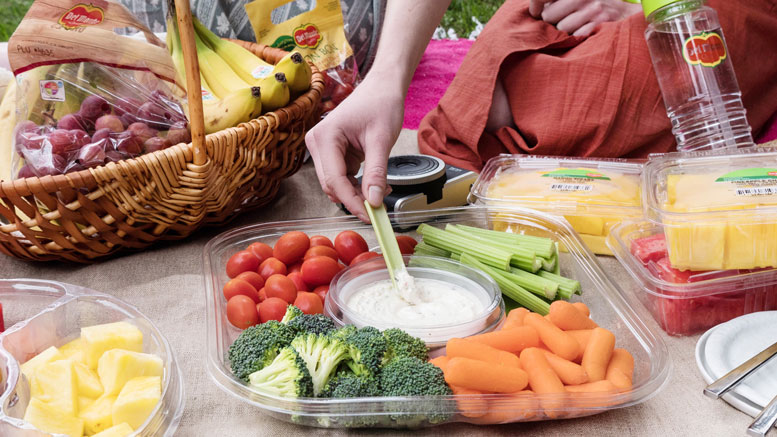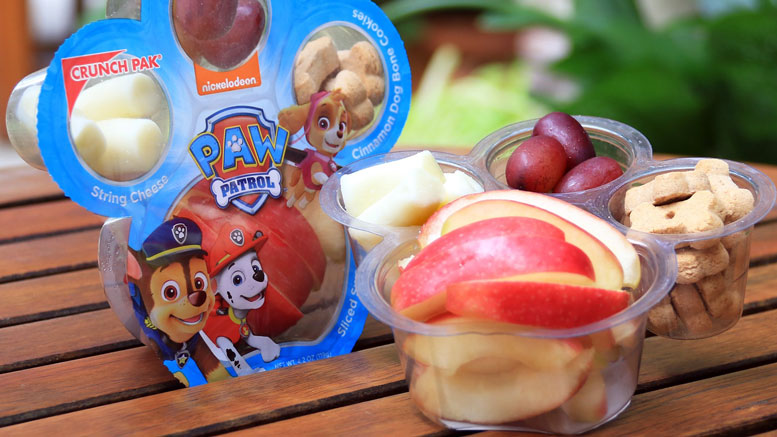Grab-and-Go Items Increase Sales During Pandemic
August 13, 2020 | 7 min to read
As consumer demand for convenience and healthy snacks rises, supermarket retailers are increasingly offering grab-and-go options, especially during the COVID-19 pandemic. Sales for prepared foods have surged, with healthy convenience items gaining traction. Retailers can enhance visibility through strategic merchandising and cross-promotion. Despite temporary declines, the grab-and-go category is expected to continue its upward trajectory, catering to busy lifestyles while emphasizing the importance of health and safety in food packaging.

Originally printed in the July 2020 issue of Produce Business.
Retailers expand offerings as convenience items becoming more popular.
As consumers focus more on convenient snacking, supermarket retailers nationwide can satisfy time-starved and on-the-run shoppers by supplying them grab-and-go options. With healthy snack options available in the produce department, consumers have more variety to select. During the COVID-19 pandemic, sales of convenience and healthy produce snacks have been increasing. Retailers can promote and merchandise grab-and-go items and see sales increase along with the trend.
Overall, the grab-and-go category is experiencing expanding sales, according to data from Chicago-based Nielsen Fresh. Within Nielsen’s total U.S. measurement, all prepared foods marked as “ready to eat” are 51% higher in year-over-year in dollar sales for the 17-week period ending June 27. Total prepared foods are up 28 percent in dollar sales for the same period, says Greg Doonan, communications manager. For the peak week ending March 21, overall produce department dollar sales were up 41 percent from the same week the year before, while overall dollar sales for the 16-week period ending June 20 increased 17.7 percent compared to the same period the previous year.
“Convenience items are very important,” says Nichole Towell, senior director of marketing for Oviedo, FL-based Duda Farm Fresh Foods, Inc. “The trend for the grab-and-go category has seen incremental growth year over year, due to demand and innovation,” she says. “As more people seek healthy and convenient solutions, we expect more and more items to join the grab-and-go category.”
Towell cited IRI Worldwide data which shows celery snack packs experiencing average weekly dollar sales increases of more than 50% since March of 2020, compared to the same time period of 2019. “Retail partners are seeking more innovative ways to capture the shopper’s attention and that is through convenience items,” she says.
The grab-and-go category took a bit of a downturn at the start of the pandemic, but when it returned, it came back strong, notes Mike Roberts, director of produce operations for Springdale, AR-based Harps Food Stores, a chain of nearly 90 stores in Arkansas, Missouri, Oklahoma and Kansas. “Initially, during COVID, people were pantry loading on staple items like carrots, onions and potatoes,” he says. “Since then, we’ve seen more of the snacking items doing well. People are cooking and snacking at home more.”
SALES INCREASING
Harps sells a variety of grab-and-go items from Ready Pac Produce and Naturipe Farms, including cut fruit, grapes and variety snack pack offerings of berries, grapes, cheese, pretzels and nuts in top sealed and peel-back packages. “Those items are selling well,” says Roberts. “With kids not being in school, and we hope they will return to school, it’s something mom and dad are probably picking up to keep their kids fed throughout the day. These are items parents are using to feed their kids while they’re home.”
With society reopening, people who once were working from home are slowly returning to offices, which means grab-and-go value-added apple snacks are in higher demand, observes Gerda Balint, marketing specialist with Crunch Pak, Cashmere, WA. “Now more than ever, consumers are purchasing groceries online for either pick-up or home delivery,” she says. “As marketers, we must truly dial in our E-commerce presence with many retailers that offer online grocery experience and have our products readily available for online purchase.”

Another area of retail that is seeing increased demand is convenience stores, which have typically offered fresh fruit convenience items and value-added grab-and-go snacks from a single refrigerated island. According to Elana Gold, chief marketing officer of Coral Gables, FL-based Fresh Del Monte Produce, “As the country continues its efforts to reopen the economy, we have seen an increase in foot traffic across the C-store Channel. Many consumers are looking for a ‘one-stop-shopping’ experience, hoping to limit their potential exposure while out. This shift has lead convenience stores to stock up on additional fresh produce, a trend we may continue to see beyond this pandemic.”
Fresh-cut processor DNO Produce, based in Columbus, OH, distributes grab-and-go ready-to-eat single-serve items to retail and foodservice customers in 15 Midwestern states. “Everyone is talking about grab-and-go,” says Alex DiNovo, president and chief operating officer, who has been on many conference calls with school foodservice personnel and state agencies. “They will not be able to serve through these lunch lines. They can throw a few apples in a bag, but they really like this grab-and-go concept. They will have to give students something to take home.”
With an emphasis on health during this uncertain period, grab-and-go convenience items seem to be a perfect fit. “From a health perspective, it is extremely important to be consuming fruits and vegetables during this time,” says Balint of Crunch Pak. “Consumers want products that have already been cleaned, cut, packaged and ready for consumption. We have state of the art technology for food safety and security. Customers can be sure that they are receiving safe to eat food.”
THE MOVE TO PACKAGED
The lack of human touch helps sell convenience items, says Towell. “At this time in history, packaging is critical as more shoppers are looking for prepackaged items due to the pandemic,” she says. “Profit margins are better on convenience items, but we recommend a mix of both bulk and convenience items to offer solutions to shoppers with varying preferences and/or immediate needs.”
Right or wrong, people are concerned about who is handling their food, says DiNovo. “Anything they can do to get ready-to-eat in a package, that’s where it will go,” he says. “There will be further demand not only in foodservice, but also in retail, due to uncertainty. There will be strong demand for grab and go items.”
Most snack items in retail are impulse buys by consumers. However, the items closest to the registers are the less than healthy grab-and-go snacks while the healthy grab-and-go snacks are in the produce section, farther from the registers, observes Balint. “End aisle healthy produce snacking displays would both help sell healthy snacks for those impulse buyers and have that healthy snack available for the health-conscious consumer,” she says.
As in-store displays can account for almost one third of purchases, visibility, color, freshness, and nutritional messaging are key factors for effective displays, says Towell. “Cross-promotion (celery sticks with dips), seasonal packaging, social media interaction and contests are key factors in grab-and-go displays,” she says. “Grouping fresh-cut together in the display helps shoppers see the products on the shelf.” Towell recommends convenience products be refrigerated.
Produce snack items such as fresh-cut apples and grapes require refrigeration to preserve their freshness. Because display space is highly valuable to retailers, marketers should work closely with retailers to position their products with good visibility and shelf space, says Balint. “As signage and merchandising are mostly controlled by the retailers due to space and aesthetics they are going for, the best ways for us to market are to use high-graphic packaging with bold colors that jump off the shelf,” she says. “We live by the three second rule: we have to get a consumers’ attention in three seconds. Other ways are through digital advertisements with established influencers and ambassadors.”
DISPLAY CONSIDERATIONS
Merchandising grab-and-go celery items can help retailers extend the larger season of celery sales. “Grab-and-go simply extends the bigger eating season of celery, which is from October through February and includes holidays such as Thanksgiving, Christmas and the Super Bowl,” says Towell. “Adding grab and go celery can increase sales in late spring through summer.”
Cross promoting is also important. Celery convenience packs should be cross-promoted with center store and dairy items where applicable. Merchandisers should consider what people pair with peanut butter, cheeses, salsas, spreadables and dips, says Towell.
Providing healthy options for children and adults is important, says Balint. “Future items should be catered toward health-conscious consumers, items that are high in protein and low in carbohydrates and sugars,” she says. “Even though convenience items are not deemed essential by consumers during pandemics, the grab-and-go items quickly jump back to being a necessity once society returns to normal. Consumers that have busy lifestyles appreciate the quick and easy snack options of grab-and-go items.”
Grab-and-go items aren’t big sellers at New Seasons Market, a 19-store Pacific Northwest chain based in Portland, OR. Sales have been flat, says Jeff Fairchild, director of produce. “It has not been a growth area for us,” he says. “In my market, it seems more people are working from home. We are seeing people more willing to take things home and cut them themselves. We don’t see as many shoppers grabbing something quickly for them or their kids on their way to work.”
Harps’ Roberts sees the category as continuing to increase. Before COVID-19 paralyzed the economy, one of Harps’ initiatives was to increase its grab-and-go product offerings. “We have seen tremendous growth in this category,” says Roberts. “We think it will continue to perform well in the foreseeable future.”
On the convenience store front, Gold from Del Monte sees C-stores growing their produce sections to become a destination area with investments in merchandising. For example, “expansion beyond just a few bananas or some cut fruit between different convenience displays to the creation of a larger section in the store should help grow produce buying and merchandising.”
11 of 17 article in Produce Business August 2020

